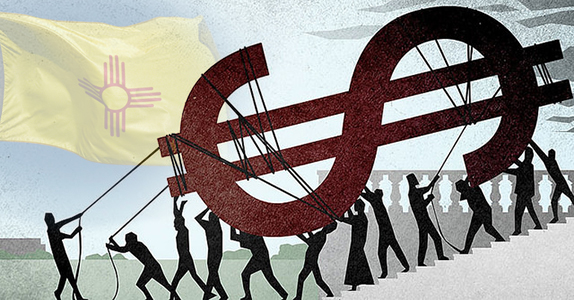
Due to the vicissitudes of our flailing media, the best and the worst economic news of the year, both released over the holidays, seem to have gone entirely unreported. The explanation is that the media are short staffed over the holidays. But so what? News is news.
First, the worst. It has been repeatedly reported that the state’s long term population growth has slowed sharply. This downturn is due to the fact that more people have been moving out of the state than into it. But it had also been repeatedly reported that due to natural population increase—the excess of births over deaths—the population was still growing.
Now we know that comforting thought is a fiction. The U.S. Census latest report shows that between July 2013 and July 2014 the state’s total population declined by 1,300 people. New Mexico was one of only six states to lose population during the period, suggesting that our own recession was a bit worse than we had imagined.
The states that lost population were Illinois (9,972 or -0.08 percent), West Virginia (3,269 or -0.18 percent), Connecticut (2,664 or -0.07 percent), New Mexico (1,323 or -0.06 percent, Alaska (527 or -0.07 percent) and Vermont (293 or -0.05 percent).
Now for the good news. The day after Christmas the state Department of Workforce Solutions (the awkward name for what used to be the Labor Department) released the strongest monthly employment report in nearly a decade. It showed that the state’s seemingly endless recession is, finally, history.
The number of jobs statewide and in all four metropolitan areas grew in the past year. In fact, the growth has taken place entirely since last summer and mostly in the past couple of months. While recent reports had hinted at this turnaround, the newest figures are really the nail in the recession’s coffin.
Here are the details, comparing November 2013 with last month:
• Statewide job growth was 1.7 percent, a gain of 14,100 jobs.
• Albuquerque jobs grew by 0.8 or 2,900 jobs.
• Las Cruces increased by 300 jobs, or 0.4 percent.
• Santa Fe grew by 0.5 percent, or 300 jobs.
• Farmington increased by 1.0 percent, or 500 jobs.
The growth was broadly based, occurring in 10 of the 13 economic areas (12 private plus government) that the state measures. In the private sector, only manufacturing and professional and business services—unfortunately two of the best paid areas, but both probably linked to reductions at the two national labs and Intel—failed to grow. Even the vital laggard of construction grew after shrinking for many years. That the private sector continued to grow, while government lost 600 jobs, in a state as overwhelmingly government-dependent as New Mexico, was also an encouraging sign that the state maybe finally be starting to wean itself off the public tit.
Education and health services, stimulated by the Obamacare and the dramatic federally financed expansion of Medicaid, led all economic areas, growing at the fastest pace since December 2012. Retail job growth between October and November was higher than in any month since measurements began in 1990.
Because this growth is so new, it has had only tangential effects on the state’s general economic mood, but that will probably change in coming months. With more jobs, people are going to be able to spend more, igniting a virtuous cycle in which spending fuels job creation, which in turns sparks more spending.
There is, of course, a fly in the ointment. Isn’t there always?
This particular fly is a rather large one with a painful bite. Plummeting prices for oil and natural gas are threatening to undermine the state’s tax revenues in a serious way since, one way or another, this industry supplies about a third of the state’s more than $6 billion annual income.
Taxes on increased business activity and higher personal and corporate incomes should fill part of the gap, but only part. The rest could be compensated for by selling bonds or by using a little of the state’s multi-billion-dollar savings accounts, called permanent funds. But with spending-adverse Republicans running the House and tight-fisted Democrat John Arthur Smith de facto leader of the Senate, those options don’t seem terribly likely. Nor is the hope of some liberal Democrats to increase revenue by legalizing and taxing marijuana likely to be realized in the face of an almost certain gubernatorial veto.
The recovery still has a long way to go. At 6.4 percent the state’s jobless rate is well above the national rate and nowhere near its pre-recession low. The double whammy of oil and gas collapse and state stringency could abort this still embryonic recovery.
But my guess is that it won’t. Some new businesses are planning to start up next year, and the minimum wage will rise to $8.75 an hour in Albuquerque as of Jan. 1. Virtuous cycles are nearly as hard to stop as to start, and this one seems to be rolling along at a merry pace.
Happy New Year.
(Photo by HonestReporting / CC)

December 30, 2014